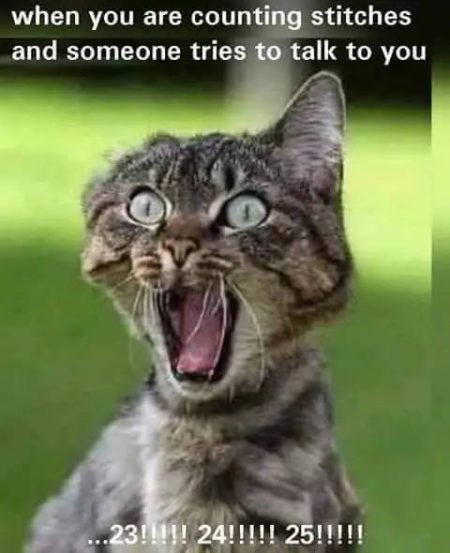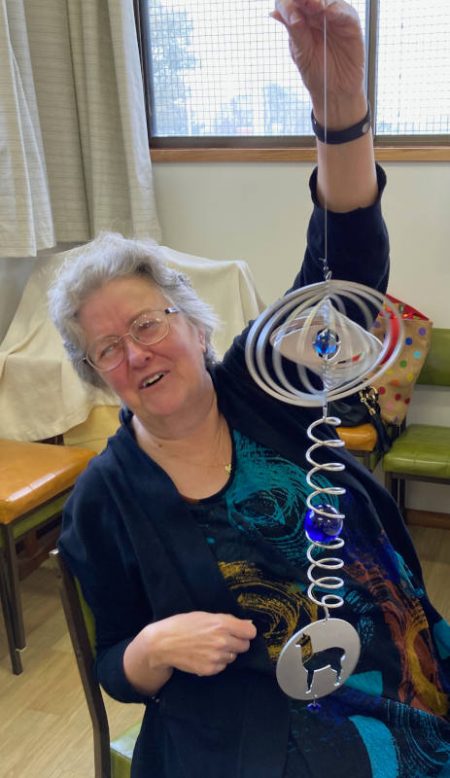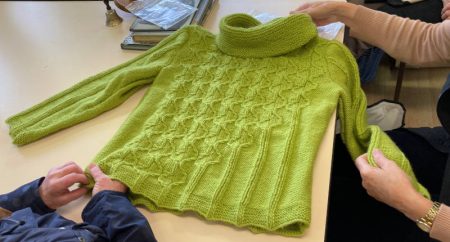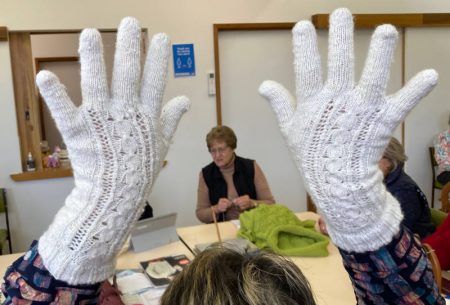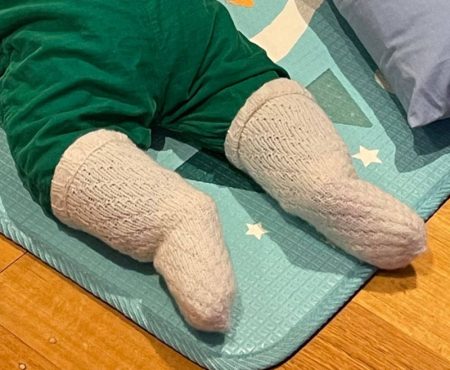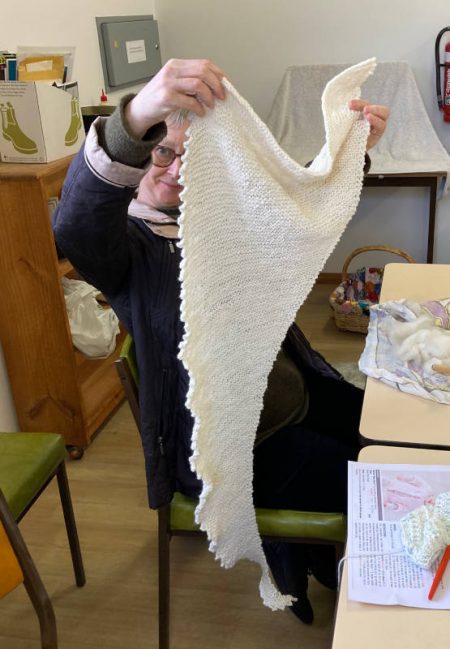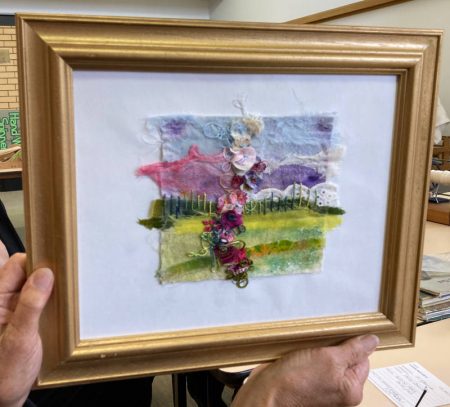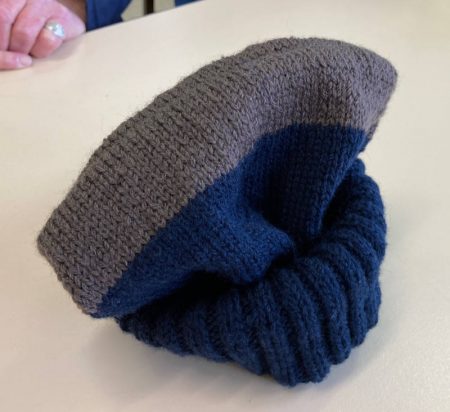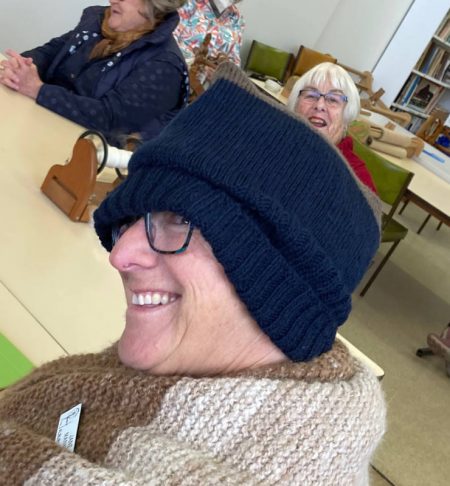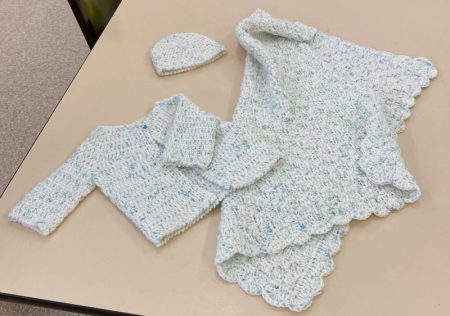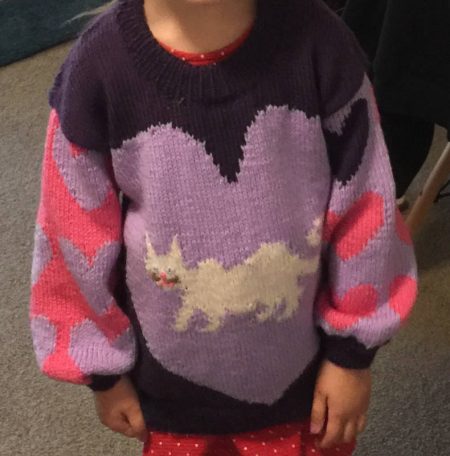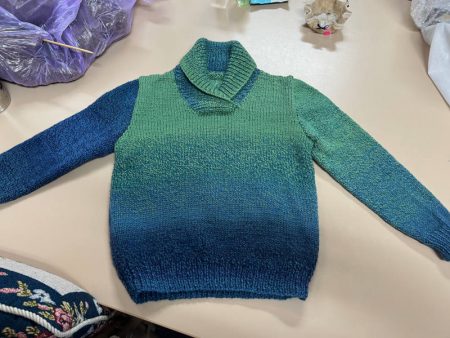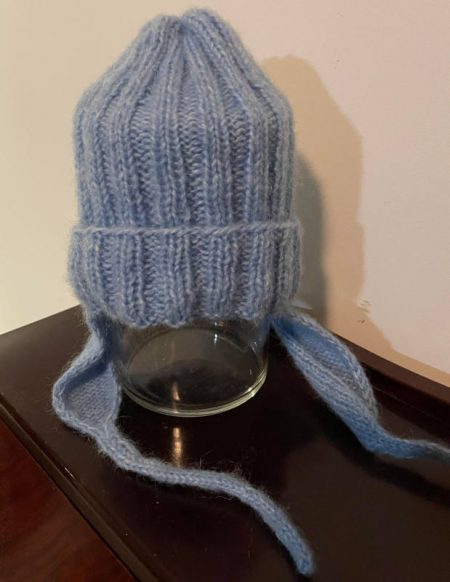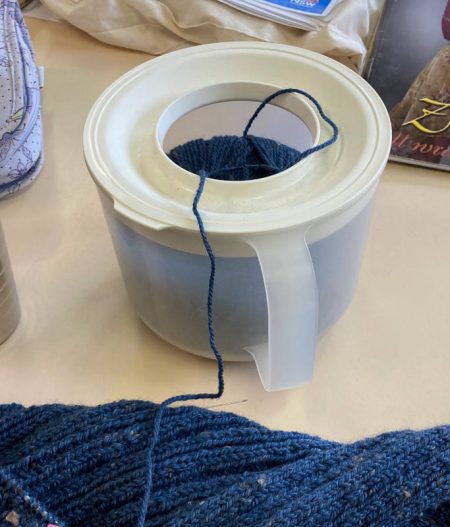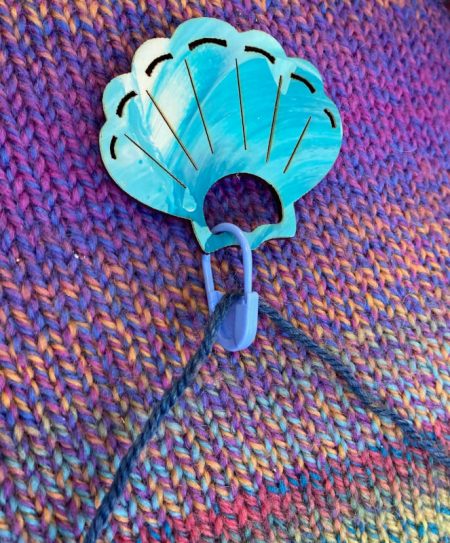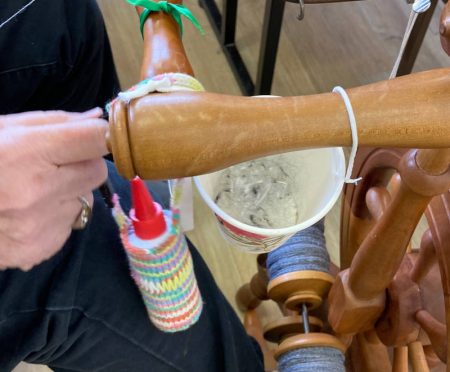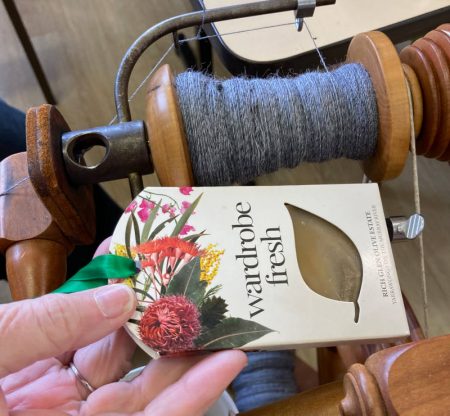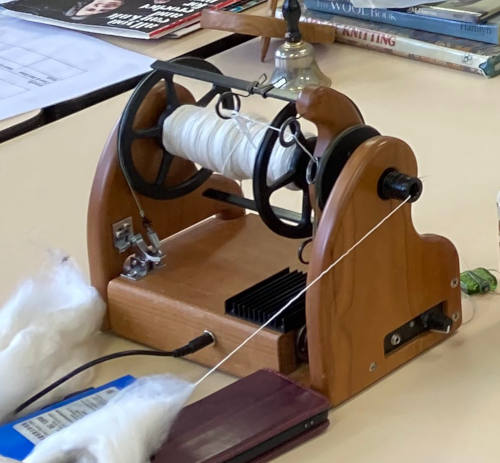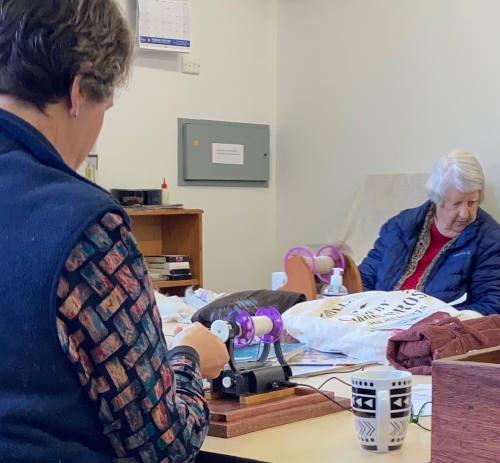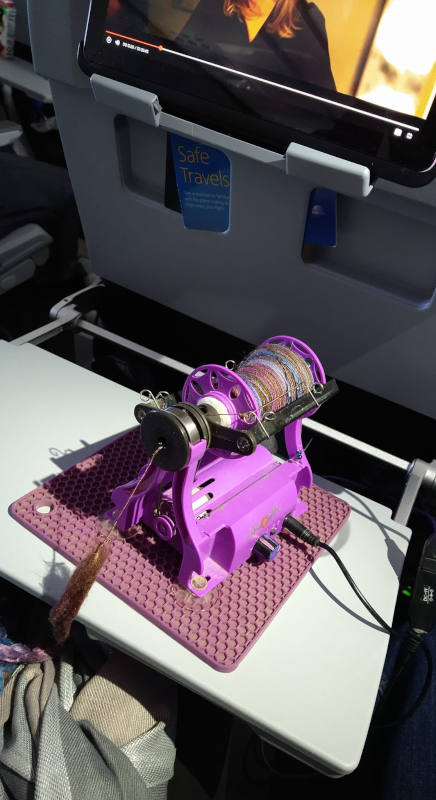
“Are we there yet?”
Spring, where are you? Had enough of the winter blues now …
School holidays have come and gone, and still the lazy winter winds blow through like they’ve come straight off the snowfields, draining every last bit of warmth. But that does not deter our brave band of fiber warriors. Winter is a great time to spin, knit and crochet, keeping fingers (and feet) moving and enjoying the warmth of a woolly project on he lap.
While most Guild Members will agree there’s something timeless and magical about traditional spinning wheels, their electrical counterparts have certainly gained in popularity over recent years. In this issue we’ll look at the appeal of these e-spinners, a little of their history, and some modern developments.
Rhonda is currently doing battle with one of our floor looms, warping it up for our learning weaving hands-on experiment. The weaving part is fun, but the art or magic lies in the warping! So let’s look at why we are putting our loom warpers through this hell and talk a little about this project below.
Do you know your fibers? Do you know where your knitting or weaving yarns come from? What they are made of? Why they are different? What fibers are better for different applications? Let’s delve a little into origins …
And Fleecy Follies – well I can tell you this cold weather does not impress our four-legged friends one little bit. There’s been plenty of short tempers, argy-bargy and spit happening at feed times. But let’s see if we can find a warming “tail” or two 😉
But first off, we’ll jump into the July Show & Tell!
Cheers all,
KathyW, Editor.
What just happened ... or not?!?
Well, the August Guild Meeting was a no-go, with some folk being away and others unwell. So there will be no August Newsletter.
Note: business that was planned will be carried forward to the September meeting on the 14th.
Also the Editor (me) has been flat chat getting my needle felting entry finished for the Royal Melbourne Show. So I’ve been a bit slack in the Newsletter department!
However, we’ve had a string of informal Show and Tells at the regular Wednesday get togethers, so there will be an August Show and Tell section here. Apologies in advance to anyone’s work I didn’t get photos of.
Committee 2022 – 2023
President:
Jane Manning
Vice President:
Debbie Carpenter
Minute Officer:
Rhonda Delahoy
Secretary(communications/events):
Julie Hofer
Assistant Secretary:
Amanda Eaton
Treasurer:
Loraine Parker
Assistant Treasurer:
Rhonda Delahoy
Newsletter Editor:
Kathy Wheeler
Library Equipment Officer:
Rhonda Delahoy
Social Media Officer:
Kathy Wheeler
Public Officer:
Julie Hofer
KeyHolders Roster
Wednesday Work Days and Meetings
1st Wed of month – Pam J
2nd Wed of month – Jane or Julie
3rd Wed of month – Heather or Rhonda
4th Wed of month – Loraine
5th Wed of month *IF* there is one – tba
Show & Tell - 13th July 2022
Deb
Lorraine
Joy
Show & Tell - July / August Addendum
Often on Wednesday Workdays we get an impromptu Show-and-Tell. These items are often gifted or sent away before we get a chance to see them at our Monthly Meeting. They are always wonderful and well deserving of inclusion in our showcase of our talented Guild member’s work.
Hints & Tips
Some of our Guild Members come up with the darnedest of clever ideas …
Know your yarn
How do you choose a yarn for a project? Or does your yarn choose the project for you? Do you have a preference? Does it even matter …
Types of Fiber for Yarns
Broadly speaking we have two basic choices in yarn – synthetic or natural.
Synthetic yarns include acrylic and nylon – produced from coal-based and petroleum chemicals; and rayon, lyocell and viscose – made from plant cellulose using a chemically intensive process.
Natural yarns are made from animal and plant fibers – protein based fibers from sheep, alpacas, llamas, camels, vicuna, goats, yaks, silk worms etc; and cellulose based using plant fibers from cotton, flax, hemp, or even nettles!
Often the choice of yarn is as simple as what is readily available.
Synthetic yarns are generally cheaper than natural yarns. Synthetic yarns are often preferred by those with certain allergies. Natural yarns, especially those grown and processed for next-to-skin application, do not have the “prickle factor” synthetic yarns and coarser natural yarns exhibit. Natural yarns are generally fire retardant, whereas synthetic yarns by virtue of their origins (petroleum by-products) can be highly combustible.
Products made from natural yarns can shrink, felt or deteriorate if not carefully washed; whereas those made from synthetic yarns are more tolerant of machine washing.
On the other hand, if you are working on a wet felted piece natural fibers that will felt are a must! Synthetic fibers and superwash will just lead to frustration unless blended with a feltable natural fiber.
You can, however, needle felt virtually any fiber, natural and synthetic – anything that will tangle!
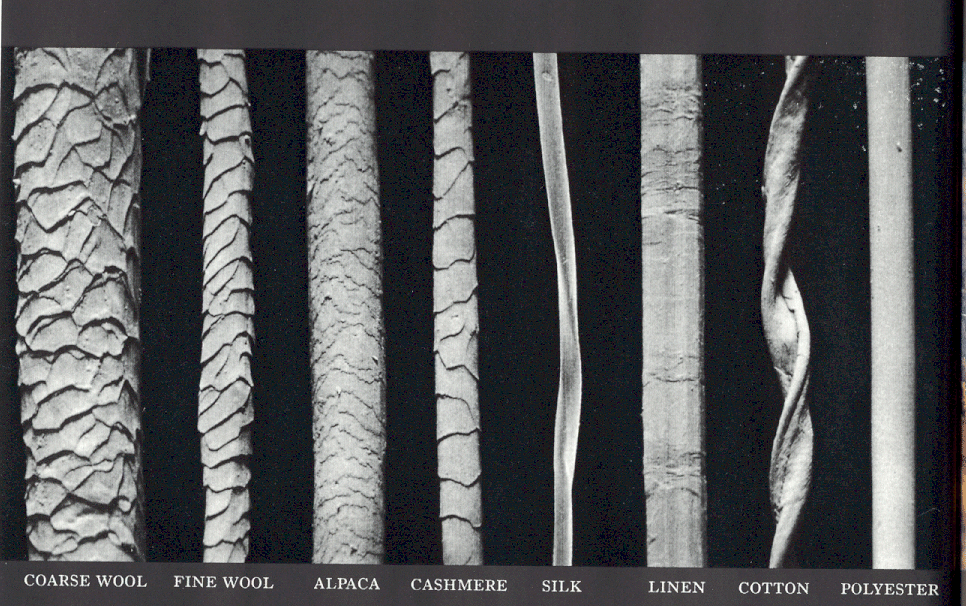
The scales on the natural protein fibers above are one of the reasons most natural fibers can easily felt – the scales can open and catch on each other as they are exposed to successive hot/cold/soap and agitation. Smooth fibers like silk won’t felt but make a great base for felting onto. Synthetic fibers being smooth like polyester generally do not felt at all.
The process of making “Superwash” wool takes a natural fiber, usually (sheeps) wool, and chemically processes it in a way that removes the tiny scales from the fiber, or coats it with an extremely fine layer of polymer plastic resin which has the same effect.
The other aspect to consider is that synthetic fibers during the normal washing process shed microfibers, or microplastics, into the environment. Natural fibers however will not shed microplastics and their natural fibers break down in the environment.
So, if you have the luxury of choosing the type of yarn for a project, there are a lot of factors to consider!
The folks at Craftsy have put together a handy guide here – How to Choose and Use the Right Type of Yarn Every Time
e-quipment
e-spinners
Traditional spinning wheels have presence, romance, and a beauty all of their own. So much so, many wheels are kept for nothing more than decoration! But lately we’ve been noticing more and more compact and convenient e-Spinners have been turning up at the Guild days.
e-Spinners are not new. For over 50 years motorised spinners have been made, often by keen hobbyists. The older models were usually crafted from timber, beautifully stained, and tied to a power outlet. These days you can get models printed by 3D printers, and powered by a re-chargeable battery! And of course there are many models and options in between these two extremes.
So, what are some of the reasons spinners put aside their gorgeous traditional wheels for these unimposing and sometimes very expensive modern compact spinners?
- Convenience – the small footprint, compact design and independent power source lends itself to situations where traditional wheels can be cumbersome. e-Spinners are easy to transport, quick and easy to set up, and are ideal for demonstration purposes.
- Power – you can use your e-Spinner almost anywhere, even during a power outage as long as your batteries are charged and you have light.
- Mobility – e-Spinners can be the size of a handbag and just as easy to transport. Traditional wheels however … ’nuff said.
- Health – various health and mobility issues can prevent spinners making full use of their traditional treadled wheels. Hip, knee, ankle, foot, even back problems can make pedalling a traditional wheel uncomfortable and sometimes impossible.
Of course, there is nothing to say you cannot have both an e-Spinner and traditional wheel(s)! There are worse things to collect …
Fleecy Follies
Keeping, breeding and raising our natural fiber animals has it’s challenges. They are like our children, needy but independent. All with unique personality traits, and all capable of having a bad day or three or being totally delightful. So here’s another fleecy story to give an insight into the world of keeping livestock.
A tale of a tail ...
Most breeds of sheep are born with tails. Quite long tails. A good sign that a nursing lamb has found mom’s milk is a furiously wriggling tail. So why do most sheep you might see in the paddock have little or no tail?
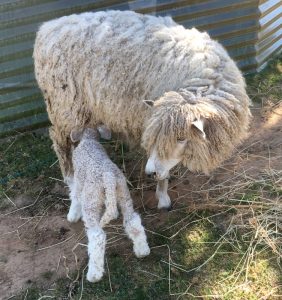
Most modern sheep breeds have been developed by humans for hundreds of years, selecting and cross breeding for desirable traits. For a long time tails were desirable as a store of rich, flavorsome meat and bred to be long and fat.
Unfortunately, long tails can become a liability under certain conditions, especially lush, wet pastures, when they get soiled and heavy with feces contributing to a build up of runny poop around the sheep’s rear end. This becomes a breeding ground for flies and a high risk for fly-strike. This debilitating condition causes infected sheep a lot of pain and discomfort, and can be fatal.
Some breeds are more prone to fly-strike than others, but general practice in Australia these days is to dock lambs tails while they are still young. Ideally, leaving enough of a tail stub to protect the animals backside from our harsh sun (yes, livestock can get sunburn too!).
While long fleece producing breeds should be tail docked for their own good, some breeds can safely keep their tails. Self shedding sheep bred for the meat market generally grow short fleeces and shed them spontaneously, rubbing the old seasons growth off on trees and fences. These breeds can keep their tails as they do not tend to fly-strike, but are often docked as a standard practice.
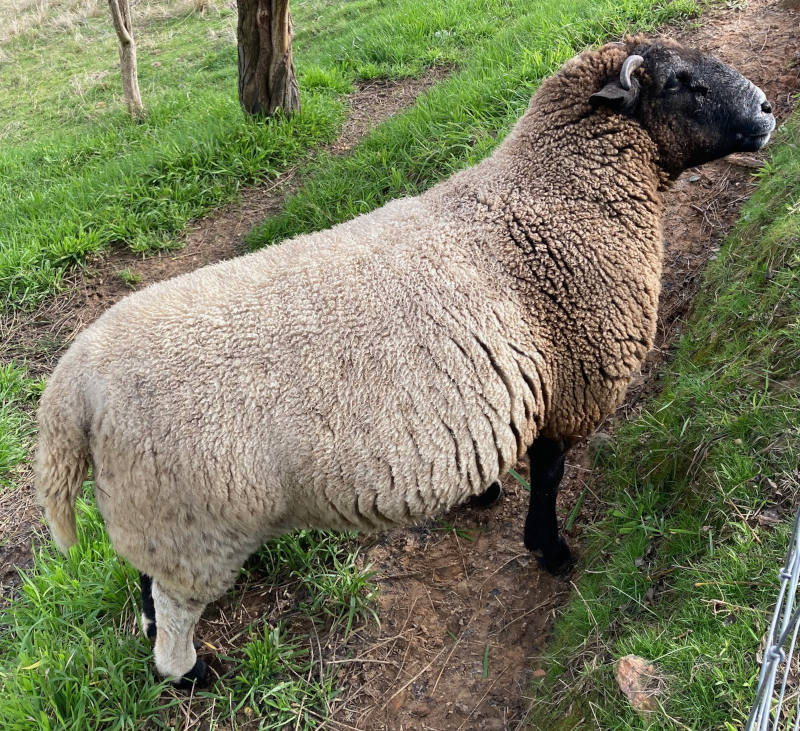
When we had our poddy dorper cross lamb wethered, we let him keep his tail. While not a full shedding sheep, his fleece regrowth is quite short and not good for much else than mulch. He has always loved his tail! It waggles when he’s happy, it waggles when he poops, and when he runs across the paddock in anticipation of food his tail swings around behind him like a helicopter rotor. Our shearers think it a bit odd, but do a good job of shearing his tail anyway.
Dorper fleece is not much use in spinning. It does have a cute crimp in it though, even being still fairly short at 12 months growth. One day I’d like to do something with it other than mulching the garden. Maybe wet felting the back of the fleece and making a seat cover or floor mat …
Do you have a funny or amazing fiber animal story? If you’d like to share it in a future Newsletter contact the Editor.
Last words ...
A few housekeeping items:
1 – Some members have been getting spam type emails saying they are coming from Guild members. If anyone gets a suspicious looking message, do not open them or any links within them.
2 – Please do not park in front of the Guild’s side double doors. This could cause a problem in the case of an emergency. Please park in the undercover area well clear of the doors and grandstand stairs, or on the grass area.
3 – The drain area outside the Guild door that fills up with water when it rains is becoming DANGEROUS with one of our members slipping in the mud and algae growing there. PLEASE KEEP WELL CLEAR OF THE DRAIN AND MUD even when it appears dry!
Newsletter contributions are always welcome. So, if anyone has anything they want to contribute, or requests for articles, email me!
Cheers for now,
KathyW, Ed.
